Many, if not most coffee purists will tell you that the French Press method of brewing sits at the very pinnacle. This method provides the best, most robust and full-bodied flavor than any other brewing method of your favorite drink.
Of course, different people look for different things where the “perfect” cup of coffee is concerned. What I might find divine may make you grimace, and so on.
That’s why, we’re going to put the French Press versus other coffee makers to see how they’re similar. Also, we’ll tackle how they’re different and how those differences impact the overall flavor of the coffee. In the end, we’ll leave you with enough information to decide which of the various famous coffee-making methods out there is the “right” one for you. Ready? Let’s get started!
What is a French Press?
In a nutshell, the French Press is a coffee-making method that sees you pouring hot water over coffee grounds, letting it steep, then using a built-in plunger to “press” the water through the grounds. Then into the bottom section of the device, a pour spout allows you to get to, drink and enjoy the finished product. The grounds are kept out of the coffee by the filter, which traps them in the upper chamber.

For best results, you’ll want to either get a fine filter, or use a relatively coarse grind setting for your beans, or both. This minimizes the number of particles that filter down into the coffee. Although, note that having a few particles in your coffee will enhance the richness and flavor of it.
The reason why this is such a popular brewing method is that it gives you an enormous amount of control over the taste and finish of the drink. If you want a stronger brew, you’ll steep for longer, or use a grind/filter combination that will allow more particles into the cup.
The steeping and plunging both help to infuse the water with more of the oils from the coffee beans. This enhances the flavor, richness and overall complexity of the finished product. For all of these reasons, purists hold the French Press versus other coffee makers in high regard.
Note that you can buy models cheaper than this, but not generally recommended. The cheaper models tend to be plastic, or at least have plastic parts, which don’t stand up to regular, rigorous use. Also, these are often flimsy and have relative weak seals, which allows more grounds into your coffee, even when you’d rather keep them out.
The good news is that if you spend a few extra dollars, you can get a device that will provide you with decades of reliable service. That’s something that none of today’s fancy electric equipment can boast! Now let’s compare this brewing method with several others.
Italian Coffee Maker vs French Press

The Italian Coffee Maker is a traditional Italian “stove top coffee.” In Italy, the brewing devices are called “Macchinettas.” In the US, you’ll see them referred to as Moka Pots.
These devices are pure simplicity. Water goes in the bottom, coffee grounds in the top. Once the machine is loaded, you put it on the stove and let the water come to a boil. As it boils, the water passes through the filter that separates the two chambers, mingling with your grounds.
It sounds a bit like an old-style percolator as it works its magic. However, the sounds are a bit more subtle and have a slightly different character.
The amount of heat you use matters when using a Moka Pot. The more heat you apply, the stronger and more bitter tasting your finished product will be.
It takes a bit of experimentation to strike just the right balance so that the bitterness doesn’t overwhelm your finished product. It is very easy for beginners to make horrible coffee using this method. There’s definitely an art to it, and when you get it right, you’ll be able to brew fantastic coffee this way, but it’s not for the faint of heart!
Our verdict: French Press vs Italian
Winner: French Press
When thinking about French Press coffee maker vs Italian Coffee Maker, here’s our honest verdict. Moka Pots are not “newbie friendly” and you can wind up making coffee that just isn’t drinkable the first several times you use this brewing method.
Aeropress Coffee Maker vs French Press
The Aeropress is a relatively new addition to coffee making. Invented in 2005 by a man named Alan Adler, this method of brewing sees coffee loosely packed into a cylinder with a filter on the bottom. Hot water is poured over the grounds and allowed to steep. The longer you let it steep, the stronger your finished product.
Typically, users of an Aeropress will allow the coffee to steep for somewhere between 10 seconds (mild coffee) to a full minute (strong, robust coffee).
Once you’ve allowed the brew to steep for as long as you prefer, you use the second cylinder. This fits into the first to press down and forces the water out the bottom into your waiting cup. The filter prevents the grounds from making their way into your cup.
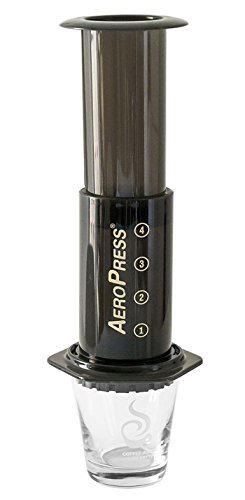
The Aeropress uses an extremely fine mesh filter, which allows you to use relatively finely ground beans. Unlike the French Press, wherein you should use a coarser grind to prevent too many particles from ending up in your drink.
Functionally, this is quite similar to the French Press. However, the Aeropress was designed to make small batches. With the French Press coffee makers, you have the capacity to satisfy several coffee drinkers at once. Fans of the Aeropress note, however, that the decision of when to press the plunger and release the coffee is entirely in human hands. This means you have a much higher, finer degree of control over the taste and finish of the coffee you get out of it.
It’s one of the few brewing methods that (arguably) has the potential to make a better tasting cup of coffee if you don’t mind putting the extra effort in!
Our Verdict: French Press vs Aeropress
Winner: French Press
The Aeropress has the potential to make a better cup of coffee, but the French Press coffee maker wins on volume and by being more hands-free.
Pour Over Coffee Maker vs French Press
The good thing about the Pour Over brewing method is that you don’t need much in the way of equipment at all. Sure, you can buy special devices if you want. However, you can also make this work with a coffee cup, a funnel (like you use to add oil to your car) and a clean sock.
This method is often affectionately called “cowboy coffee,” and often used by campers out in the wild. If you forgot to pack an Aeropress, you can, with a bit of ingenuity, still enjoy a hot cup of your favorite morning beverage.
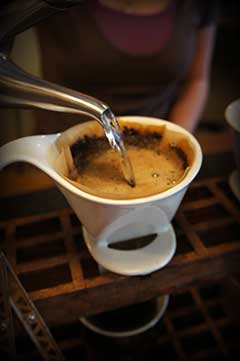
As you might have guessed, the sock (or filter, if you’d rather not use your socks) goes into the funnel. Coffee goes into the filter. Heat water to the desired temperature and slowly pour the hot water over the grounds. Soak them all thoroughly.
If you’re noticing that the water is coming out of the bottom too quickly, you can add a cotton ball at the end of the funnel. This will slow the drip, allowing the coffee to steep longer before it hits your cup. The advantage to using an actual sock is that you can pull it out of the funnel and give it a squeeze to get more of the water out. However, that’s something that only the most die-hard of “Cowboy coffee” drinkers do.
The result is an amazingly stout cup of coffee, although we have to say that this is a relatively niche brewing method. It’s better suited to camping than to your kitchen. There are simply better, more effective and efficient ways of getting a good cup of coffee. Although if your coffee maker should ever break, keep this method in mind.
Our Verdict: French Press vs Pour Over Coffee Maker
Winner: French Press
But hey, if you’re camping, by all means, grab the nearest sock and go!
Chemex Coffee Maker vs French Press
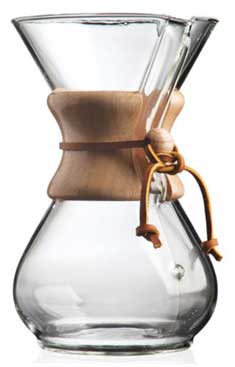
You may not have heard of this device, but it has been billed as one of the best-designed products of all time. When you look at it, what you’ll find is a glass flask shaped a lot like a pitcher on the bottom and a funnel on the top. Sound familiar? It should, because this brewing method is virtually identical to the “Cowboy Coffee” method described above.
The filter goes on the top, coffee goes into the filter. Then, the hot water is slowly poured over the grounds where it will seep through them. Afterwards, it goes through the filter, and then into the bottom half of the flask. Once the process is complete, just remove the filter and pour straight from the container.
It’s functionally similar to the “pour over” method and delivers comparable results. You can control the strength of your creation by packing the grounds more tightly. This will slow down the filtration to the lower chamber so that more steeping occurs. This is, in effect, a way of “fancying up” Cowboy coffee making techniques, and making it more applicable for home use.
The upshot is that this flask holds thirty ounces. Whereas most traditional pour over methods are only good for one cup at a time, so you get coffee in something closer to bulk using this method.
Our Verdict: French Press Coffee Maker vs Chemex
Winner: French Press
What’s our comparison for French Press vs Chemex? For the Chemex, design is innovative, but this is basically “Cowboy Coffee” in your kitchen. It’s a neat niche product and is fun to fool around with, though.
Vacuum Coffee Maker vs French Press
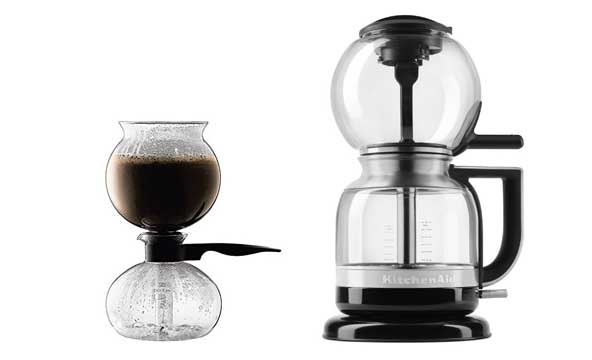
Functionally, this brewing method is quite similar to the way a Moka Pot operates. However, the design is a bit different. Where the Moka Pot relies entirely on gravity, the Vacuum Coffee maker relies on a vacuum siphon to pull the heated water (and steam) up.
Starting from the lower chamber, then into the upper where the grounds are waiting. And then it allows gravity to return the finished coffee slowly to the bottom chamber. Afterward, the lower chamber cools sufficiently that the pressure in it drops.
You can get vacuum coffee makers in various sizes. Here are two examples, one fairly small, and one larger (looking at the images, you’ll have a better understanding of how they function).
Because it’s a bit of a process to make all of that work, using a vacuum coffee maker can be a bit of a ritual. Unsurprisingly then, it has become the most popular brewing method in Japan, a nation known for its rituals. Taste-wise, it makes coffee on par with what you’d get out of a Moka Pot.
Similar to the Moka Pot, the more heat you apply to the lower chamber, the stronger and more bitter your finished product is likely to be. Though in this case, the reason is that the more heat you apply to the bottom, the longer it will take for the pressure in the lower chamber to drop, which is required to release the water from top to bottom.
Our Verdict: French Press vs Vacuum Coffee Maker
Winner: Tie
It’s true that it takes some work to get the flavor right in the Vacuum maker. But, there’s something soothing and marvelous about the ritualistic nature of making coffee this way. Even so, if you’re in a hurry, and don’t have the time or patience for the ritual, use the French Press.
Keurig Coffee Maker vs French Press
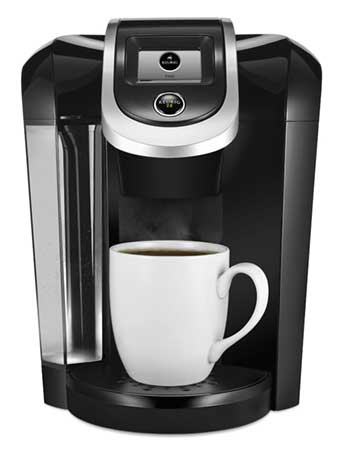
Keurig changed the way America, and most of the world consumes coffee. Rather than by the pot, Keurig wants you to make and drink it one cup at a time. It’s a strategy that’s working. Millions of households now sport one, and they’re a common sight in offices around the world.
The great thing about Keurig is that there are so many flavors of their K-Cup coffee “pods” to choose from. It’s not just coffee, either. You can get health drinks, tea, and a stunning array of hot chocolate variants, all made from the same little unit sitting on your counter. The variety alone is enough to keep your taste buds happy for years to come.
You will, however, wind up paying about $0.75 a cup for your Keurig creations. That’s far less than you’d pay at the Starbucks down the block, of course. However, it’s also far more than you’d’ pay if you bought beans, ground them, and made it yourself. Still, we place a premium on convenience, and nothing is more convenient than a Keurig.
Let’s set aside the vast assortment of flavors for a moment (which is a dazzling selling point). The bottom line is that K-cups make, at best, a decent cup of coffee. Again, for most folks, decent is good enough. Also, the fact that you’re not getting a truly outstanding cup of coffee is easily offset by the fact that you could have a different drink every day of the year from the same machine if you wanted to.
Even so, this is not the machine that a coffee enthusiast would naturally gravitate towards. This one is better suited to a busy household with lots of coffee drinkers, each with very different tastes and preferences. For those people, the Keurig is almost a must-have.
Our Verdict: French Press vs Keurig Coffee Maker
Winner: French Press by a mile
The Keurig is neat, and if you’re looking for variety, this is the machine you want. But, in terms of producing a quality cup of coffee, there’s no contest here.
Drip Coffee Maker vs French Press

Even if you’re not a huge fan of coffee, you undoubtedly know about this brewing method. Found in almost every home in America, the drip coffee maker is a standard kitchen accessory.
Design wise, it’s fairly straightforward. These machines have a tank that holds water. It also has a filter chamber, which houses the filter where it spreads the coffee grounds. Turning the device on activates the boiler and the pump.
The water is heated to just below the boiling point (the exact temperature varies from one brand to the next). Then, the hot water is slowly fed into the filter chamber, where it drips into the pot waiting beneath it.
Quality wise, you’re never going to hear anyone raving about barista level coffee from a drip machine. No matter how fancy or expensive it might be. The best you can hope for here is a “good” cup of coffee. However, some of the cheaper drip machines can’t even manage that reliably.
Even so, unless you’re a die-hard coffee fanatic, a “good” cup of coffee is probably just fine. It’s certainly better than none at all. What you invariably end up with is a fairly mild brew that’s warm, but not usually genuinely hot.
Be advised that coffee from a drip machine is best when consumed shortly after brewing. If the pot of coffee is allowed to sit on the warming plate, you could wind up drinking something with a slightly burnt aftertaste.
One way to increase the strength of the brew is to either run without a filter or to pack more coffee simply into the filter chamber. Running without a filter will leave you with a fair collection of particles in your coffee. Meanwhile, increasing the amount will see you burning through your supplies at an alarming rate, so neither is a perfect solution.
Then again, for most people, a decent cup of coffee is all they’re looking for. If that describes you, then a drip machine will meet your needs just fine.
Our Verdict: French Press vs Drip Coffee Maker
Winner: French Press
Again, no contest. The French Press versus other coffee makers wins every time on quality. If you’re looking for hassle-free convenience, however, the drip machine is the right pick for you.